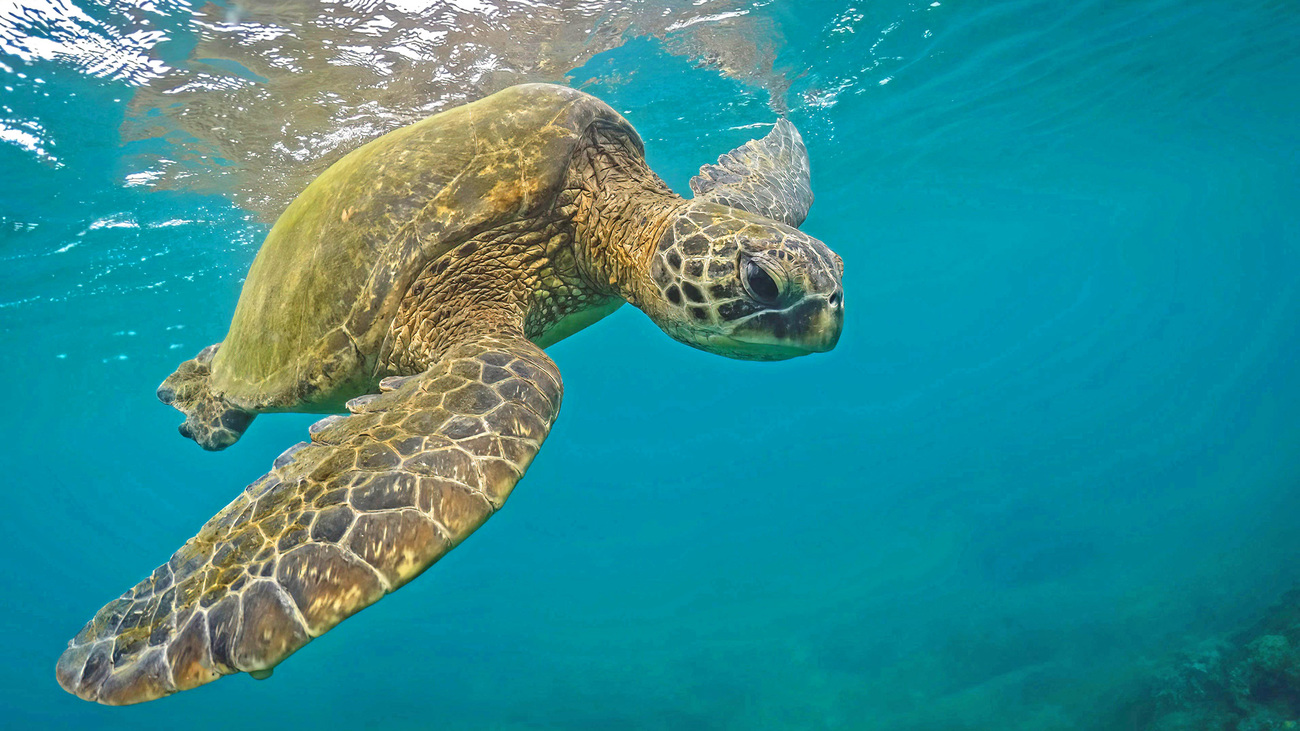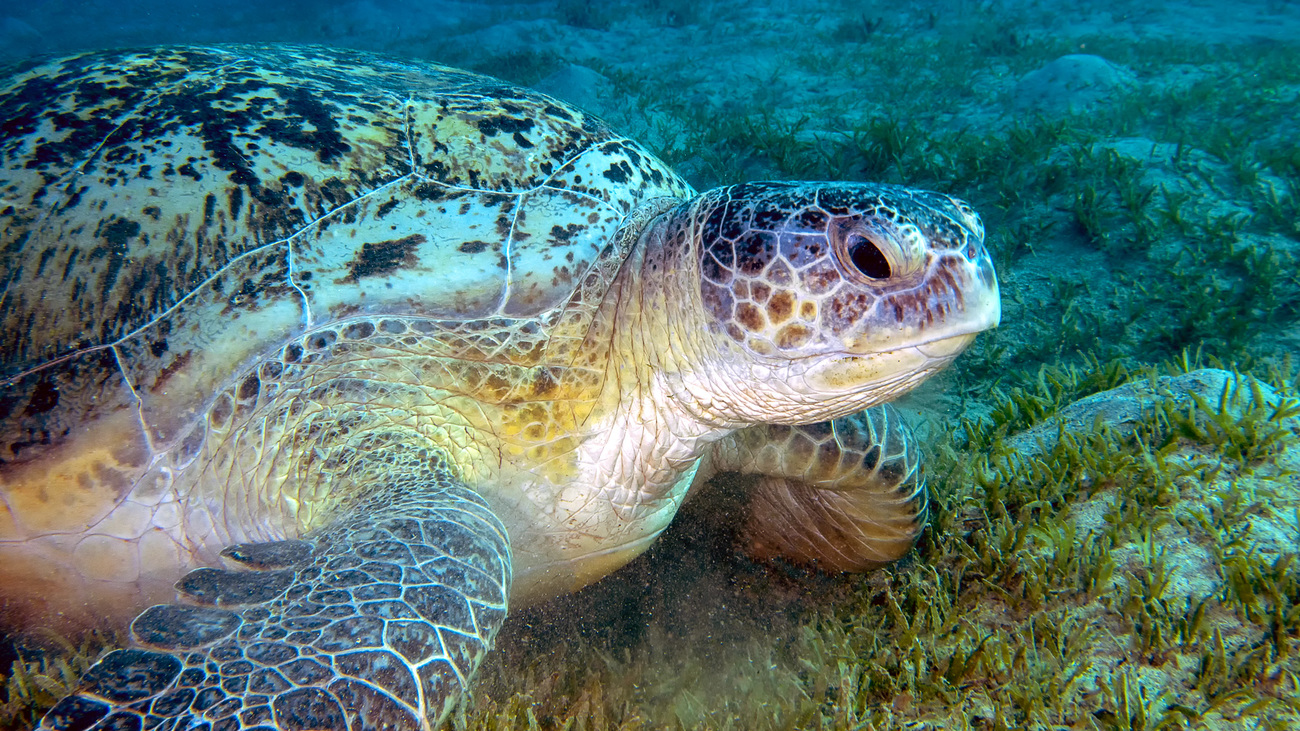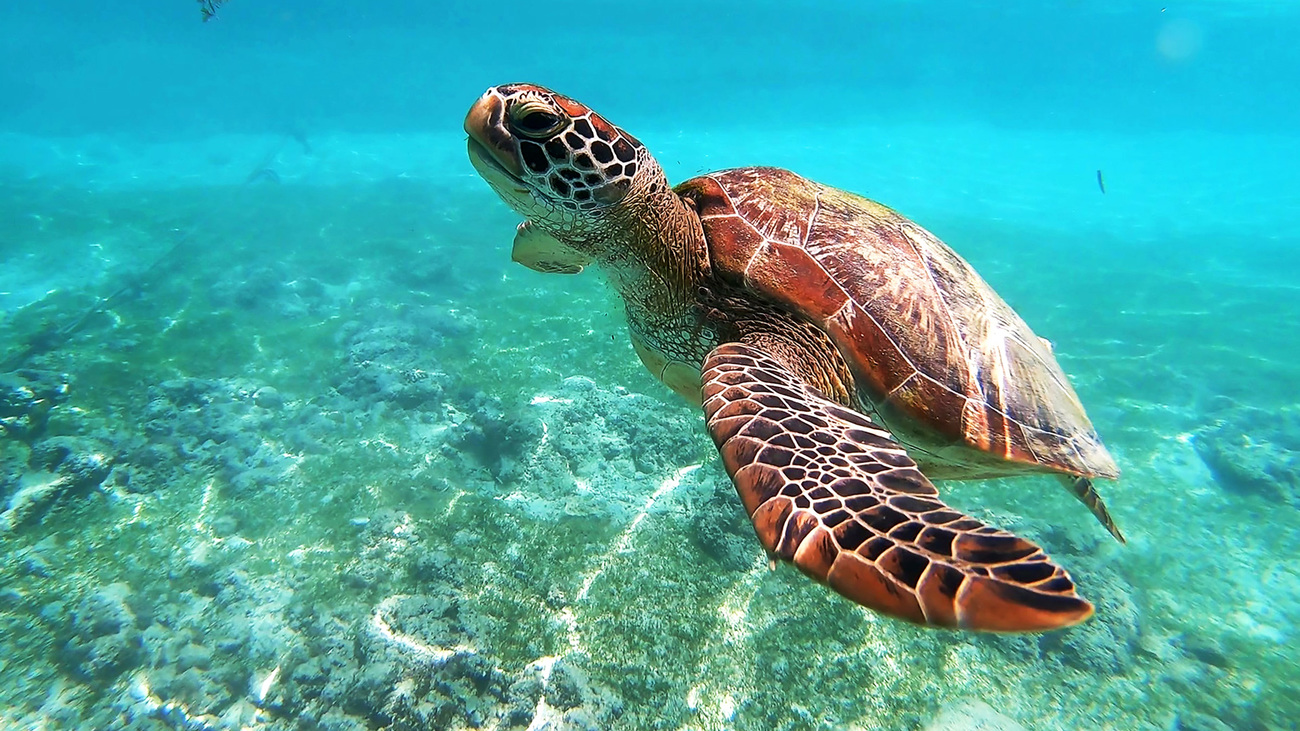Green turtles
Green turtles are a species of sea turtle known for their green colour. Green sea turtles are one of the seven species of sea turtles and are the largest hard-shelled sea turtles in the world.
The green sea turtle’s size varies between about 0.9 to 1.2 meters (3 to 4 feet) long, and they weigh about 135 to 158 kilograms (about 300 to 350 pounds). Green turtles have distinctive colouring with dark brown, grey, or olive green shells and lighter yellow or white undersides.
Green sea turtles primarily inhabit tropical and subtropical coastal waters and prefer to live in coral reefs, seagrass beds, and coastal lagoons. They are herbivores, and their diet consists mainly of seagrasses and algae.
Green turtles are distributed in oceans worldwide, with significant populations in the Atlantic, Pacific, and Indian Oceans. They are often seen in the Caribbean, around the Hawaiian Islands, and in the Great Barrier Reef.
Mating in green turtles typically occurs offshore. Males pursue females, and the couples engage in underwater displays of copulation. Then the female green turtles return to the same beaches where they hatched to lay their eggs.
They dig nests in the sand and deposit clutches of eggs, which incubate for approximately two months before the hatchlings emerge and make their way to the sea.
After nesting, female green turtles embark on long migrations, while males tend to stay closer to the breeding areas. These migrations can span hundreds to thousands of kilometres, even crossing oceans.
Green turtles are endangered due to threats of habitat destruction, fishing bycatch, and poaching, leading to extensive conservation efforts to protect their populations and nesting sites.
Green turtles are considered a keystone species, which means they play an important role in marine ecosystems and help maintain the ocean’s ecological balance.
One way in which they do so is through their eating habits. By grazing on seagrass beds, they prevent overgrowth, benefiting other marine animals.
These seagrass beds sequester significant amounts of carbon dioxide from the atmosphere, playing a role in mitigating climate change. By grazing on them, sea turtles help to keep these grasses healthy.
What is a green sea turtle’s scientific name?
The green sea turtle’s scientific name is Chelonia mydas. It is the only member of the genus Chelonia.
Their common name, green sea turtle, can be traced back to their diet. As herbivores, they mainly consume seagrass and algae. This diet gives their fatty tissue a greenish colour, which is how they got their name.
Are green turtles endangered?
Yes, green sea turtles are endangered. The IUCN Red List has classified them as endangered since 1982.
In fact, nearly all species of sea turtles are now classified as endangered, with three of the seven existing species classified as critically endangered.
Where do green turtles live?
Green turtles live in tropical and subtropical waters throughout the world.
There are 11 distinct population segments of green turtles listed under the Endangered Species Act, all of which are under threat.
Green sea turtles are highly migratory creatures and travel great distances, sometimes hundreds to thousands of kilometres, between their foraging grounds and nesting locations. While this is necessary for their survival, it does make them difficult to track.
Green turtles nest on land in over 80 countries and inhabit the coastal waters of over 140 countries.
Threats
Green sea turtles face several threats that endanger their populations and ecosystems.

Bycatch
Bycatch is the primary threat facing green turtles in every region they inhabit worldwide.
Green turtles are often unintentionally caught in various fishing gear, such as gillnets, longlines, and trawl nets, by fishermen targeting other species. These entanglements can lead to injuries, drowning, and death, particularly in areas with heavy fishing activity.
Harvest of turtles and eggs by humans
Green turtles have historically been hunted and killed for their fat, meat, and eggs. Despite regulations increasing in the past century, hunting turtles has largely contributed to the decline of the species in ways that are difficult to reverse.
Both adult turtles and their eggs are still routinely harvested for various purposes, including meat, shells, and traditional medicines. Despite their endangered status, poaching sea turtles isn’t illegal everywhere in the world, which causes problems for conservation programmes.
Habitat degradation and loss
Green turtles’ marine and land habitats are threatened by coastal development, rising sea levels, artificial lighting, seawall construction, and pollution from land-based sources.
Destruction of nesting beaches and seagrass beds can disrupt the turtles’ life cycles, while sea-based pollution (including light and sound pollution) can disorient the hatchlings as they make their way into the ocean for the first time.
Vessel strikes
Green turtles come up to the water’s surface to breathe. While at the surface, they are in danger of being struck by various boats and ships.
Vessel strikes can result in injuries or fatalities for green turtles, especially in high-boat traffic areas such as inlets and marinas.
Ocean pollution
Contaminants like plastics and chemicals in the oceans can be ingested by green turtles, leading to health issues that can be fatal. This pollution can include oil spills and marine debris like fishing lines, balloons, plastic bags, plastic straws, and discarded fishing gear.
Additionally, polluted waters disrupt the marine ecosystems where green turtles live, reducing the availability of their primary food sources, such as seagrasses and algae.
Climate change
Green sea turtles face several issues related to climate change. Rising temperatures affect the ratio of male to female hatchlings, as different temperatures are necessary for the development of the two sexes in sea turtles. If temperatures continue to rise, this could lead to a shortage of male green turtles, which would slow reproduction.
Additionally, rising sea levels impact nesting sites, and changing ocean currents affect the distribution of their food sources.
Disease
Green turtles are susceptible to fibropapillomatosis. This disease causes internal and external tumours that affect turtles’ ability to swim and feed and can be fatal. Fibropapillomatosis may be linked to habitat degradation.
Some sea turtle health issues can be exacerbated by pollution and human activity.
FAQs
Where are green turtles found?
Green turtles are found around the world in subtropical and tropical waters.
They inhabit regions such as the Caribbean, the Hawaiian Islands, the Great Barrier Reef in Australia, the Galápagos Islands, and the coasts of North and South America, Africa, and Asia.
These turtles are known for their migratory behaviour, moving between foraging and nesting sites, and they are often found around seagrass beds and coral reefs.
What is the lifespan of a green turtle?
Turtles and tortoises have a reputation for having long lifespans, and green turtles are no exception.
Green turtles can live for up to 70 years. Female green turtles reach maturity at 25 to 35 years.
Do green sea turtles migrate?
Yes, green sea turtles migrate great distances (hundreds to thousands of kilometres) across the ocean between their feeding grounds and nesting grounds.
Typically, they migrate to breed and lay eggs every two to five years.

Where do green sea turtles lay their eggs?
Green turtles lay eggs on sandy beaches. Females leave the ocean and choose a spot to lay their eggs, often doing so on the same beach where they hatched.
On average, green turtles lay around 100 to 200 eggs in a pit on the beach far from the shoreline, cover the eggs with sand, and then return to the sea.
The eggs hatch after about two months, and the hatchlings make their way from the sand into the ocean.
Turtle hatching periods tend to be a tourist attraction, as people flock to beaches to watch the newly hatched turtles make their way into the water.
How fast can a green sea turtle swim?
Green turtles have an average swimming speed of around three kilometres per hour (less than 2 miles per hour).
However, if they feel threatened, they can swim in bursts of up to 35 kilometres per hour (22 miles per hour), giving them enough speed to escape any immediate threat.
Do green turtles need air?
Green turtles are reptiles and need air to breathe. However, they are well adapted to living most of their lives underwater and can spend long stretches without coming up for air.
They can hold their breath for between four to seven hours while resting, during which time their heart rate slows to help them conserve oxygen.
Do green turtles sleep underwater?
Like other sea turtles, green turtles can sleep at the water’s surface in deeper water.
In coastal waters, they can sleep on the ocean floor, anchoring themselves by wedging their bodies under rocks in coastal waters.
Why are green turtles endangered?
Green turtles have been listed as endangered since 1982. They have a decreasing population due to various threats, including:
- Hunting and poaching of turtles and eggs
- Climate change
- Ocean pollution
- Habitat loss
- Fishing bycatch
- Vessel strikes
How can we save green sea turtles?
We can take action to help preserve this beautiful and essential marine species.
Here are a few ways you can help green sea turtles:
- Reducing marine debris that could be eaten by turtles
- Cleaning up coastlines and beaches to prevent pollution
- Refraining from disturbing turtles, nests, or hatchings
- Keeping nesting beaches dark so as not to disrupt the turtles that come ashore
- Avoiding single-use plastics like straws and shopping bags
Our work
Turtles need protection both at sea and on land. Because they can be found in almost every ocean worldwide, they require dedicated conservation efforts to ensure the continuation of the species.
At IFAW, we work with partners on the ground, including the Australian Seabird Rescue, in their efforts to rescue, rehabilitate, and release sea turtles back into the ocean. We have provided critical resources including turtle tubs, heaters, and scales to assist with rehabilitation and care to help give injured or sick sea turtles the best chance of survival. In 2021, they rescued and treated an injured green sea turtle before releasing it back into the ocean.

In Mexico, where six out of the seven marine turtle species nest, IFAW is working with Mayan fishermen communities to promote coexistence between their domestic animals and endangered species. IFAW improves domestic animals’ health by vaccinating, deworming, and sterilising them, and we also work to provide pens to prevent dog interactions with marine turtles. Keeping dogs in their pens during the evenings and nights is the most effective way to prevent dog predation on turtles’ nests and on adult turtles while nesting.
In coastal Kenya, IFAW is working to reduce pressures on marine species and ecosystems and increase effective protection measures. Our work focuses on population studies of sea turtles and other key species, conservation and rescue training of key government personnel and community members, and decreasing turtle entanglements and ingestion through improved waste management.
How can you help?
One of the best ways to help green sea turtles is to learn more about the threats they’re facing. IFAW is dedicated to combating vessel strikes, bycatch, and other issues impacting green turtles and other marine life. Supporting our conservation efforts will help reduce these threats to the green turtle’s survival.
You can also reduce your use of single-use plastics, clean up beaches where turtles lay their eggs, and avoid disturbing their nests, eggs, and hatchlings.
